|
|
|
Sort Order |
|
|
|
Items / Page
|
|
|
|
|
|
|
| Srl | Item |
| 1 |
ID:
113464
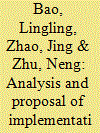

|
|
|
|
|
| Publication |
2012.
|
| Summary/Abstract |
In China, northern heating region contains approximately 6.5 billion m2 residential building areas accounting for 15% of the total residential living areas of urban and rural. About 70% of the urban residential buildings in north China are high energy consumption buildings. The task of heat metering and energy efficiency retrofit of 0.15 billion m2 existing residential buildings in northern heating areas of China in "the 11th Five-Year Plan" period was proposed by the Ministry of Housing and Urban-Rural Development (MOHURD) in 2007 and completed in 2010. This paper introduced both central and local governments' efforts on organization, implementation and finance, etc. Then several retrofitting effects involving improving the people's livelihood, mobilizing the enthusiasm of residents for the retrofit and driving the development of relevant industries were presented. Finally, on the basis of analyzing the issues encountered in the progress of the retrofit in the past 4 years, the paper gave some policy proposals on organization system, financing models, reward mechanism, and heating system reformation to help to promote the energy efficiency retrofit in "the 12th Five-Year Plan" period.
|
|
|
|
|
|
|
|
|
|
|
|
|
|
|
|
| 2 |
ID:
088202
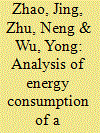

|
|
|
|
|
| Publication |
2009.
|
| Summary/Abstract |
According to statistics and field investigation, the energy consumption situation and reality of commercial building is described in this paper. As the first step of large-scale public building energy efficiency supervision system encouraged by central government of China, the energy consumption of several typical commercial buildings and public buildings was analyzed in detail. The main contents of investigation are as follows: basic information of building, operational record of energy consumption equipment, energy consumption of indoor equipments, energy-efficiency assessment of energy consumption systems and equipments, investigation of behavior energy saving, etc. On this basis further analysis and diagnosis including indoor thermal and humid environment, operation state of air-conditioning water system, operation state of air-conditioning duct system and operation management of air-conditioning system were implemented. The results show that the most energy consumption of buildings in this city is commercial buildings, which can reach to about 240 W/m2 per year. Further analysis tells that air conditioning systems play the major role of building energy consumption, and building energy saving has great potential in this city. In this paper, the ways of diagnosis work for building energy consumption are also described and discussed. Reasonable test, diagnosis and analysis are meaningful for building energy efficiency retrofit and management.
|
|
|
|
|
|
|
|
|
|
|
|
|
|
|
|
| 3 |
ID:
088208
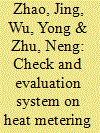

|
|
|
|
|
| Publication |
2009.
|
| Summary/Abstract |
Heat metering and energy efficiency retrofit of existing residential buildings in northern heating areas of China is organized and implemented in a large scale by local government in 15 provinces of North China with the unified guidance and control of central government. Firstly, this paper introduced the target of energy-saving reformation of existing residential buildings in North China and the importance of check and evaluation on this target, then pointed out the necessity of building up an evaluation system for energy-saving retrofit. According to the analytical hierarchy process (AHP), three-grade evaluation system was built up for heat metering and energy efficiency retrofit of existing residential buildings in northern heating areas of China. Also, based on multi-index comprehensive evaluation method combined with life cycle assessment (LCA) theory, post-evaluation thought and successful degree evaluation method, a mathematical model was established. Finally, a set of scientific method for evaluating heat metering and energy efficiency retrofit of existing residential buildings in northern heating areas of China systematically, scientifically, comprehensively and objectively was created.
|
|
|
|
|
|
|
|
|
|
|
|
|
|
|
|
| 4 |
ID:
088200
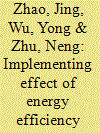

|
|
|
|
|
| Publication |
2008-09.
|
| Summary/Abstract |
The Chinese central government released a document to initiate a task of energy efficiency supervision system construction for government office buildings and large-scale public buildings in 2007, which marks the overall start of existing buildings energy efficiency management in China with the government office buildings and large-scale public buildings as a breakthrough. This paper focused on the implementing effect in the demonstration region all over China for less than one year, firstly introduced the target and path of energy efficiency supervision system, then described the achievements and problems during the implementing process in the first demonstration provinces and cities. A certain data from the energy efficiency public notice in some typical demonstration provinces and cities were analyzed statistically. It can be concluded that different functional buildings have different energy consumption and the average energy consumption of large-scale public buildings is too high in China compared with the common public buildings and residential buildings. The obstacles need to be overcome afterward were summarized and the prospects for the future work were also put forward in the end.
|
|
|
|
|
|
|
|
|
|
|
|
|
|
|
|
| 5 |
ID:
125631
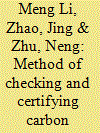

|
|
|
|
|
| Publication |
2013.
|
| Summary/Abstract |
In China, the area of existing buildings in urban and rural has exceeded 43 billion m2 at present and more than 90% of them are high energy consumption buildings, which have poor thermal insulation performance, low energy efficiency technologies and equipments, and severe energy waste in HVAC system. Carbon trading in construction field not only promotes energy efficiency retrofit of existing buildings and energy-saving technologies, but also reduces the financial pressure of government. The most important technical issue is how to estimate the carbon trading volume reasonably. Based on the requirements of energy efficiency retrofit of existing buildings, relevant national or professional standard standards and CDM small scale project methodologies, this paper puts forward a simplified and practical method of checking and certifying the carbon trading volume of existing buildings retrofits in China and calculates four typical cases for trail. Moreover, a comprehensive methodological framework is presented to make the method guide actual cases more directly and apparently. The framework comprises project analysis, scenario determination, data collection and envelope calculation.
|
|
|
|
|
|
|
|
|
|
|
|
|
|
|
|
| 6 |
ID:
088205
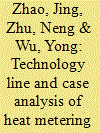

|
|
|
|
|
| Publication |
2009.
|
| Summary/Abstract |
The building area in northern heating areas accounting for 70% of the total land area in China is 6,500,000,000 m2. The average heating energy consumption in northern China is 100-200% times more than developed countries in the same latitude. This paper introduced firstly the heat metering and energy efficiency retrofit background of existing residential buildings in northern heating areas of China organized by mohurd and MOF, and then put forward the total principle and contents of retrofit. Through analyzing some retrofit cases in Germany, Poland and China, some technological experiences were summarized and finally a technology line suitable for heat metering and energy efficiency retrofit of existing residential buildings in northern heating areas of China which involved retrofit for heat metering and temperature regulation of heating systems, heat balance of heat source and network, and building envelope was described to provide a systematic, scientific, technological guide for the retrofit projects of 0.15 billion m2 in "the Eleventh Five-Year Plan" period.
|
|
|
|
|
|
|
|
|
|
|
|
|
|
|
|
|
|
|
|
|